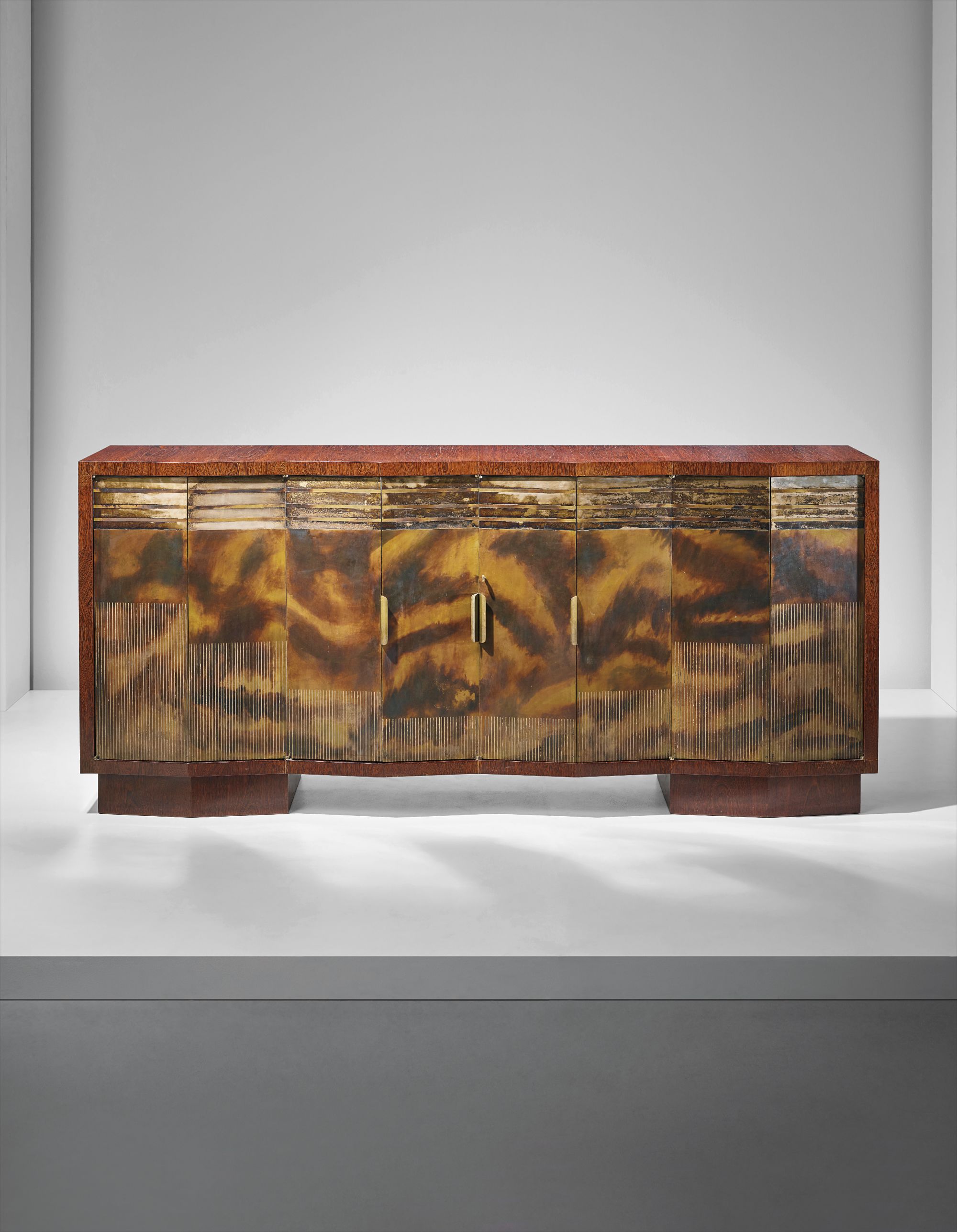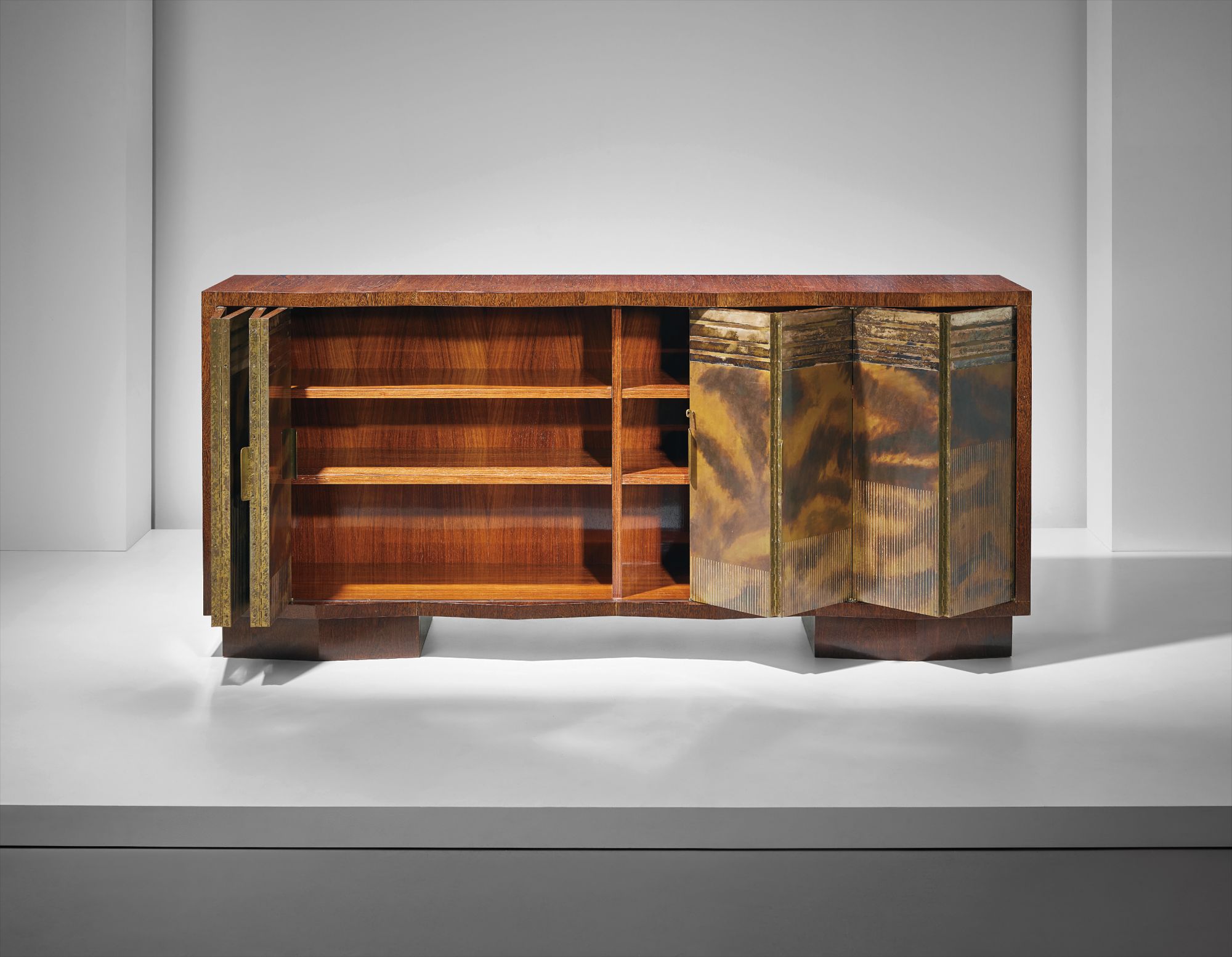



431Σ
Eugène Printz and Jean Dunand
Important sideboard
circa 1927
Kekwood-veneered wood, rosewood-veneered wood, enameled bronze with dinanderie, brass.
36 3/8 x 78 7/8 x 17 7/8 in. (92.4 x 200.3 x 45.4 cm)
Reverse impressed twice E.PRINTZ.
Full-Cataloguing
A nearly identical example of the present model, illustrated on the previous page, was exhibited at the 1927 Salon d’Automne, Paris.
The present lot exhibits the mastery and singularity Eugène Printz and Jean Dunand attained by combining traditional craftsmanship with a modern aesthetic. Printz, trained in cabinetmaking techniques from the ancien régime, approached his furniture as works of art through which he pushed technical and stylistic boundaries. Similarly, Dunand utilized traditional lacquering and metalsmithing methods to develop innovative surface effects. The moment that this sideboard was created represents the inception of Printz’s mature style and also marks the beginning of a long collaboration between the two master craftsmen. The synergy between Printz and Dunand resulted in a progressive iteration of Art Deco that anticipated modern furniture of the following decades.
Printz started his career by specializing in expert recreations of eighteenth-century furniture, a trade he learned from his cabinetmaker father. Around 1925, Printz decisively transitioned styles to engage the contemporary French mode of the 1920s while maintaining his devotion to high craftsmanship. He began exhibiting his modern designs regularly at the major Paris expositions to critical acclaim. The present sideboard is nearly identical to a second example that was shown at the 1927 Salon d’Automne. The critic Ernest Tisserand commented on the exhibition by stating, “Eugène Printz has outdone himself. Rarely have we seen a finer piece of work than this… Its ingenuity is prodigal and its taste exquisite; all the resources of cabinet-work are here brought to perfection” (quoted in Guy Bujon, E. Printz, Paris, 1986, p. 68). Such praise was seconded by Léandre Vaillat, who wrote in Le Temps, “Thus proceeds Eugène Printz, with a sideboard whose material, form, and presentation have made it the chef d’œuvre of this years’ Salon d’Automne” (Ibid). A consummate work of art, the sideboard characterizes Printz’s output of this period. He had recently shifted from primarily using rosewood to incorporating luxurious woods such as kekwood along with metal and lacquer details. The cubistic sculptural form of the sideboard is typical of Printz’s work from the late 1920s, as is the geometric patterning mixed with organic surface effects of the natural woodgrain and Dunand plaques.
In addition to the virtuoso woodworking, the sideboard reflects the legacy of the ancien régime through its functionality and innovative use of materials. Printz often integrated ingenious moving components in his furniture, similar to the mechanical furniture from the eighteenth century. The doors of the 1927 sideboard cleverly slide and fold open to stack neatly at the sides. Printz repeated the sliding door system elsewhere, frequently with metal accents akin to the plaques created by Dunand.
It was, in fact, near this time that Printz and Dunand initiated their relationship, a collaboration that continued for the duration of Dunand’s life. By the 1920s, Dunand had achieved renown for his metal and lacquer work. He had studied lacquerware with a Japanese master craftsman and implemented the traditional labor-intensive technique in his inventive designs. The façade of the present sideboard demonstrates dinanderie, a revival of a medieval method of treating bronze with inlay, lacquer, and other materials. The use of metal in the sideboard also recalls Boulle work and bronze mounts from the era of Louis XIV and XV, while simultaneously forecasting the importance of metals in modernist furniture at large and in Printz’s œuvre in particular during the 1930s. In the design and construction, the present sideboard revitalized artistry from the past into a unique Art Deco idiom that looked ahead to the materials and functionality of burgeoning modernism.
The present lot exhibits the mastery and singularity Eugène Printz and Jean Dunand attained by combining traditional craftsmanship with a modern aesthetic. Printz, trained in cabinetmaking techniques from the ancien régime, approached his furniture as works of art through which he pushed technical and stylistic boundaries. Similarly, Dunand utilized traditional lacquering and metalsmithing methods to develop innovative surface effects. The moment that this sideboard was created represents the inception of Printz’s mature style and also marks the beginning of a long collaboration between the two master craftsmen. The synergy between Printz and Dunand resulted in a progressive iteration of Art Deco that anticipated modern furniture of the following decades.
Printz started his career by specializing in expert recreations of eighteenth-century furniture, a trade he learned from his cabinetmaker father. Around 1925, Printz decisively transitioned styles to engage the contemporary French mode of the 1920s while maintaining his devotion to high craftsmanship. He began exhibiting his modern designs regularly at the major Paris expositions to critical acclaim. The present sideboard is nearly identical to a second example that was shown at the 1927 Salon d’Automne. The critic Ernest Tisserand commented on the exhibition by stating, “Eugène Printz has outdone himself. Rarely have we seen a finer piece of work than this… Its ingenuity is prodigal and its taste exquisite; all the resources of cabinet-work are here brought to perfection” (quoted in Guy Bujon, E. Printz, Paris, 1986, p. 68). Such praise was seconded by Léandre Vaillat, who wrote in Le Temps, “Thus proceeds Eugène Printz, with a sideboard whose material, form, and presentation have made it the chef d’œuvre of this years’ Salon d’Automne” (Ibid). A consummate work of art, the sideboard characterizes Printz’s output of this period. He had recently shifted from primarily using rosewood to incorporating luxurious woods such as kekwood along with metal and lacquer details. The cubistic sculptural form of the sideboard is typical of Printz’s work from the late 1920s, as is the geometric patterning mixed with organic surface effects of the natural woodgrain and Dunand plaques.
In addition to the virtuoso woodworking, the sideboard reflects the legacy of the ancien régime through its functionality and innovative use of materials. Printz often integrated ingenious moving components in his furniture, similar to the mechanical furniture from the eighteenth century. The doors of the 1927 sideboard cleverly slide and fold open to stack neatly at the sides. Printz repeated the sliding door system elsewhere, frequently with metal accents akin to the plaques created by Dunand.
It was, in fact, near this time that Printz and Dunand initiated their relationship, a collaboration that continued for the duration of Dunand’s life. By the 1920s, Dunand had achieved renown for his metal and lacquer work. He had studied lacquerware with a Japanese master craftsman and implemented the traditional labor-intensive technique in his inventive designs. The façade of the present sideboard demonstrates dinanderie, a revival of a medieval method of treating bronze with inlay, lacquer, and other materials. The use of metal in the sideboard also recalls Boulle work and bronze mounts from the era of Louis XIV and XV, while simultaneously forecasting the importance of metals in modernist furniture at large and in Printz’s œuvre in particular during the 1930s. In the design and construction, the present sideboard revitalized artistry from the past into a unique Art Deco idiom that looked ahead to the materials and functionality of burgeoning modernism.